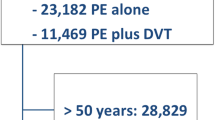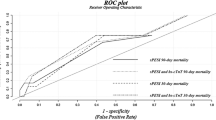Abstract
Prognostic stratification of acute pulmonary embolism (PE) remains a challenge in clinical practice. Simplified PESI (sPESI) score is a practical validated score aimed to stratify 30-day mortality risk in acute PE. Whether prognostic value of sPESI score differs according to sex has not been previously investigated. Therefore the aim of our study was to provide information about it. Data records of 452 patients, 180 males (39.8 %) and 272 females (60.2 %) discharged for acute PE from Internal Medicine wards of Tuscany (Italy) were analysed. sPESI was retrospectively calculated. Variables enclosed in sPESI score, all cause in-hospital mortality and overall bleedings were compared between sexes. Moreover, predictive ability of sPESI score as prognosticator of all cause in-hospital mortality was tested and compared between sexes. sPESI score 0 (low risk) was found in 17.7 % of males and 13.6 % of females (p = 0.2323). We didn’t find significant difference in sPESI scoring distribution. Age ≥80 years (51.4 vs. 33.8 %, p = 0.0003) and heart rate ≥110 bpm (23.5 vs. 14.4 %, p = 0.0219) were found significantly more prevalent in females, whereas active cancer (23.8 vs. 39.4 %, p = 0.0004) and cardio-respiratory diseases (19.8 vs. 27.7 %, p = 0.0416) were in males. All cause in-hospital mortality was 0 % in both genders for sPESI score 0, whereas it was 5.4 % in females and 13.6 % in males with sPESI score 1–2 (p = 0.0208) and 22 % in females and 19.3 % in males with sPESI score ≥3 (p = 0.7776). Overall bleedings were significantly more frequent in females compared with males (4.77 vs. 0.55 %, p = 0.0189). In females overall bleedings ranged from 2.7 % in sPESI score 0 to 6 % in sPESI score ≥3. Predictive ability of sPESI score as prognosticator of all cause in-hospital mortality was higher in females compared to males (AUC 0.72 vs. 0.67, respectively). In real life different co-morbidity burdens in females compared to males. Females seems to be at lower risk of all cause in-hospital mortality for sPESI score ≤2 but at higher risk of bleeding, irrespective from sPESI scoring. Predictive ability of sPESI score seems better in females.



Similar content being viewed by others
References
Jiménez D, Aujesky D, Moores L et al (2010) RIETE Investigators. Simplification of the pulmonary embolism severity index for prognostication in patients with acute symptomatic pulmonary embolism. Arch Intern Med 170:1383–1389
Konstantinides S, Torbicki A, Agnelli G, Authors/Task Force Members et al (2014) ESC Guidelines on the diagnosis and management of acute pulmonary embolism: The Task Force for the Diagnosis and Management of Acute Pulmonary Embolism of the European Society of Cardiology (ESC)Endorsed by the European Respiratory Society (ERS). Eur Heart J 2014(35):3033–3069
Masotti L, Pieralli F, Panigada G et al. (2015) Characteristics and clinical management of acute pulmonary embolism in real world: findings from TUSCAN-PE Study. Ital J Med 9:121–129
Schulman S, Kearon C on behalf of the SubCommittee on Control of the Anticoagulation of the Scientific and Standardization Committee of the Intrnational Society of Thrombosis and Haemostasis (2005) Definition of major bleeding in clinical investigations of antihemostatic medicinal products in non-surgical patients. J Thromb Haemost 3:692–694
Blanco-Molina A, Enea I, Gadelha T et al (2014) RIETE Investigators. Sex differences in patients receiving anticoagulant therapy for venous thromboembolism. Medicine 93:309–317
Borrero S, Aujesky D, Stone RA, Geng M, Fine MJ, Ibrahim SA (2007) Gender differences in 30-day mortality for patients hospitalized with acute pulmonary embolism. J Womens Health 16:1165–1170
Lapner S, Cohen N, Kearon C (2014) Influence of sex on risk of bleeding in anticoagulated patients: a systematic review and meta-analysis. J Thromb Haemost 12:595–605
Fermann GJ, Erkens PM, Prins MH, Wells PS, Pap ÁF, Lensing AW (2015) Treatment of pulmonary embolism with rivaroxaban: outcomes by simplified pulmonary embolism severity index score from a Post hoc analysis of the EINSTEIN PE study. Acad Emerg Med 22:299–307
Author information
Authors and Affiliations
Corresponding author
Additional information
On behalf of TUSCAN-PE Study Investigators are listed in “Appendix”.
Electronic supplementary material
Below is the link to the electronic supplementary material.
Appendix
Appendix
The TUSCAN-PE Study Investigators
Luca Masotti (Medicina Interna, Ospedale Santa Maria Nuova, Firenze, Italy), Grazia Panigada (Medicina Interna, Ospedale di Pescia, Pescia, Italy), Giancarlo Landini (Medicina Interna, Ospedale Santa Maria Nuova, Firenze, Italy), Filippo Pieralli (Medicina Interna, Azienda Ospedaliera Universitaria Careggi, Firenze, Italy), Francesco Corradi (Medicina Interna, Azienda Ospedaliera Universitaria Careggi, Firenze, Italy), Salvatore Lenti (Medicina Interna, Ospedale San Donato, Arezzo, Italy), Rino Migliacci (Medicina Interna, Ospedale di Cortona, Cortona, Italy), Carlo Nozzoli (Medicina Interna, Azienda Ospedaliera Universitaria Careggi, Firenze, Italy), Maddalena Grazzini (Medicina Interna, Azienda Ospedaliera Universitaria Careggi, Firenze, Italy), Lucia Ciucciarelli (Medicina Interna, Azienda Ospedaliera Universitaria Careggi, Firenze, Italy), Alessandro Morettini (Medicina Interna, Azienda Ospedaliera Universitaria Careggi, Firenze, Italy), Sara Bucherelli (Medicina Interna, Azienda Ospedaliera Universitaria Careggi, Firenze, Italy), Alessandra Petrioli (Medicina Interna, Azienda Ospedaliera Universitaria Careggi, Firenze, Italy), Carlotta Casati (Medicina Interna, Azienda Ospedaliera Universitaria Careggi, Firenze, Italy), Mario Felici (Medicina Interna, Ospedale San Donato, Arezzo, Italy), Luciano Ralli (Medicina Interna, Ospedale San Donato, Arezzo, Italy), Stefano Arrigucci (Medicina Interna, Ospedale San Donato, Arezzo, Italy), Laila Teghini (Medicina Interna, Ospedale di Pescia, Pescia, Italy), Giovanni Antonio Porciello (Medicina Interna, Ospedale di Cortona, Cortona, Italy), Stefano Spolveri (Medicina Interna, Ospedale di Borgo San Lorenzo, Florence, Italy), Daniele Baldoni (Medicina Interna, Ospedale di Borgo San Lorenzo, Florence, Italy), Anna Frullini (Medicina Interna, Ospedale di Borgo San Lorenzo, Florence, Italy), Barbara Cimolato (Medicina Interna, Ospedale Santa Maria Nuova, Firenze, Italy), Gianni Lorenzini (Medicina Interna, Ospedale di Cecina, Italy), Alessandro Pampana (Medicina Interna, Ospedale di Cecina, Italy), Guidantonio Rinaldi (Medicina Interna Ospedale di Barga Lucca, Italy), Maria Chiara Bertieri (Medicina Interna Ospedale di Barga Lucca, Italy), Raffaele Laureano (Medicina Interna Ospedale di Barga Lucca, Italy), Stefano Tatini (Medicina Interna Ospedale di Barga Lucca, Italy), Alberto Fortini (Medicina Interna, Ospedale San Giovanni di Dio, Florence, Italy), Chiara Angotti (Medicina Interna, Ospedale San Giovanni di Dio, Florence, Italy), Valerio Verdiani (Medicina Interna Ospedale di Grosseto, Italy), Anna Maria Romagnoli (Medicina Interna Ospedale di Grosseto, Italy), Irene Cascinelli (Medicina Interna Ospedale di Grosseto, Italy), Alberto Camaiti (Medicina Interna Ospedale di Livorno, Italy), Nicola Mumoli (Medicina Interna Ospedale di Livorno, Italy), Marco Cei (Medicina Interna Ospedale di Livorno, Italy), Stefano Giuntoli (Medicina Interna Ospedale di Livorno, Italy), Massimo Alessandri (Medicina Interna, Ospedale di Massa Marittima, Italy), Alessandro De Palma (Medicina Interna, Ospedale di Massa Marittima, Italy), Maurizio Manini (Medicina Interna, Ospedale di Orbetello Grosseto, Italy), Veronica De Crescenzo (Medicina Interna, Ospedale di Orbetello Grosseto, Italy), Michele Piacentini (Medicina Interna Ospedale di Piombino, Italy), Carlo Passaglia (Medicina Interna, Ospedale Cisanello Pisa, Italy), Giancarlo Tintori (Medicina Interna, Ospedale Cisanello Pisa, Italy), Carlo Palermo (Medicina Interna Ospedale di Campostaggia Siena, Italy), Alba Dainelli (Medicina Interna Ospedale di Campostaggia Siena, Italy), Roberto Andreini (Medicina Interna Ospedale di Pontedera, Italy), Giuseppa Levantino (Medicina Interna Ospedale di Pontedera, Italy), Plinio Fabiani (Ospedale di Portoferraio Livorno, Italy), Lucia Raimondi (Ospedale di Portoferraio Livorno, Italy), Massimo Di Natale (Medicina Interna Ospedale di Prato, Italy), Filippo Risaliti (Medicina Interna Ospedale di Prato, Italy), Rossella Nassi (Medicina Interna Ospedale di San Sepolcro Arezzo, Italy), Roberta Mastriforti (Medicina Interna Ospedale di San Sepolcro Arezzo, Italy), Roberto Cappelli (Medicina Interna Ospedale Le Scotte Siena, Italy), Michele Voglino (Medicina Interna Ospedale Le Scotte Siena, Italy), Paola Lambelet (Medicina Interna Ospedale di Viareggio, Italy), Stefano Fascetti (Medicina Interna Ospedale di Viareggio, Italy), Adriano Cioppi (Medicina Interna Ospedale di Viareggio, Italy), Valentina Carli (Medicina Interna Ospedale di Viareggio, Italy), Alessandro Tafi (Medicina Interna Ospedale di Volterra, Italy), Simone Meini (Medicina Interna Ospedale di Volterra, Italy), Emilio Santoro (Medicina Interna Ospedale di Bibbiena, Arezzo, Italy), Claudia Rosi (Medicina Interna, Ospedale di Bibbiena, Arezzo, Italy).
Rights and permissions
About this article
Cite this article
Masotti, L., Panigada, G., Landini, G. et al. Simplified PESI score and sex difference in prognosis of acute pulmonary embolism: a brief report from a real life study. J Thromb Thrombolysis 41, 606–612 (2016). https://doi.org/10.1007/s11239-015-1260-0
Published:
Issue Date:
DOI: https://doi.org/10.1007/s11239-015-1260-0




